Retinas reveal future health, and the first cells on Earth
In this episode of The Naked Scientists: what the structure of your retina reveals about your risk of developing a range of diseases; have we finally cracked how the first biological cells appeared 4 billion years ago; and how pond skater insects survive potentially lethal run-ins with large raindrops.
In this episode
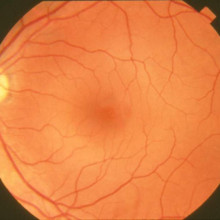
Retina scans reveal your future health
Maryam Zekavat and Nazlee Zebardast, Mass Eye and Ear
A new study has found that the structure of the retina in the back of the eye can reveal a host of diseases that a person is at risk from developing. By using machine learning to marry up changes seen in retinal images with health and genetic data from tens of thousands of people who participated in the UK’s Biobank study, Mass Eye and Ear hospital ophthalmologists Maryam Zekavat and Nazlee Zebardast think they have a way of using the retina to see what a person’s future health looks like…
Nazlee - In recent years, we have come to realise that we can find out a lot more information from images of the eye than we ever thought was possible. And it's opened up this really exciting area of research. And we were fortunate enough to have access to an incredible resource, specifically a large, large study of about half a million people from the UK called the UK Biobank. And we had images of people's eyes and we were wondering, is there a link between images of the eyes? And Maryam will talk a little bit more about how those were obtained and ocular and systemic disease.
Chris - Maryam, what are these pictures you've got of people's eyes? Are you looking at the outside or are you talking about what's going on inside the eye?
Maryam - It's inside the eyes. The human retina is a multi-layered tissue, which offers a really unique window into systemic health. So here we're looking specifically at that retina, which is composed of nine different layers using OCT imaging, optical coherence tomography imaging, and that's a non-invasive imaging that uses light waves to take a cross-section picture of your retina. And so we had this OCT imaging available across 50,000 individuals in this biobank
Chris - And Nazlee, why should looking at the different layers of the retina give us an insight into a person's overall health or disease risk?
Nazlee - Some of it is actually really surprising. So for example, we didn't know before the machine learning models came out that we could tell someone's age just by looking inside their eyes, or their sex even. But the retina is a very intricate tissue. It's an extension of your brain essentially. And so it's constructed of all these different cell layers that are connected to our brain and our systemic health, or essentially your overall health. So you can look at people's eyes and when they say the eye is a window into your soul, they're not really kidding because you're seeing what is going on with someone's heart, someone's blood pressure, potentially even how they're breathing or their risk of having certain neurologic problems.
Chris - And Maryam, when you did this study, what did you actually measure and what did you marry up with what?
Maryam - So what we measured was the thickness of each of these nine layers of the retina. And we used this measurement to then look at connections to systemic health to disease and also to genetics.
Chris - Nazlee, one of the key things about any kind of disease, we always say prevention is better than cure. So the critical question I can ask you is if you do this, does it give you a window into the early stages of a disease at a time when you might be able to intervene meaningfully in a person before they actually get sick from something?
Nazlee - It's interesting that you ask that. One of the key pieces of analysis that we did in this manuscript was looking at future risk of disease. So looking at someone's retinal thickness and determining if that was linked to future disease diagnosis. And in fact, the layer thicknesses of the retina are predictive of future diseases of the heart, of the brain, of the kidneys, of the lungs, including eye diseases as well. So even though this needs to be confirmed, our study does point to the fact that we can use retinal thicknesses or retinal phenotypes to be able to predict disease before it happens and intervene.
Chris - So would the approach be then that rather than subjecting a person to a whole raft of different tests and blood samples and genetic analyses, you could plunk them down in front of you, use this technique to look at their retinal structure and then based on what you've learned about the associations between the different shapes and structures of the retina and different disease outcomes, you could make predictions about what a person might be about to develop or indeed is developing right now and then you can make obviously interventions as necessary.
Nazlee - Precisely. I think that is exactly how we envision results like this being used. As Maryam previously mentioned. Also, the OCT or these light pictures of the eye are routinely used in clinical practice in ophthalmology. And so you can imagine if someone comes in for their eye exam, then you can use this information to tell them you seem to have a high risk of MS or you have a high risk of high blood pressure, or you might have a high risk of developing diabetes, so you should go see your primary care doctor. The other way you can think about this is exactly as you said is what if we just had this as a screening tool where people would come in, get images of their retina noninvasively without having to do all these extra tests and they could know that they have risk for certain diseases that they need to get checked for or even treated for potentially.
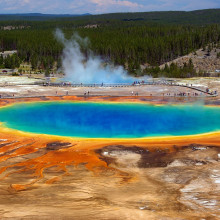
07:07 - Hydrothermal vents source of first cell membrane material
Hydrothermal vents source of first cell membrane material
Jon Telling, Newcastle University
The origin of life on Earth - and beyond - is a mystery, and, arguably, one of the most important questions to answer. We know that life started simply, probably with self-replicating chemical reactions most likely based around something similar to the DNA molecules we rely on to carry our genetic code today. But, pretty quickly, those reactions found a way to wrap themselves up inside oily membranes that could protect them from the surroundings and make the process more reliable and efficient. Hey presto, the cell was born. But where did those membranes, made of fatty acids, come from in the first place? That question has bothered biologists for decades. Now, though, researchers at Newcastle University have recreated in the lab the conditions around hydrothermal vents, also known as underwater black smokers. These conditions, Jon Telling has found, can spontaneously generate the very molecules that scientists have been searching for…
Jon - There's a few lines of evidence that point towards these hydrothermal vents, these hot springs, as a likely place for where life originated. People have tried to find out what the earliest cell that everything originates from was like, and what they've deduced from looking at the genes is that the first cell - known as the 'last universal common ancestor' - liked it hot, it probably lived off hydrogen gas, and it would've used carbon dioxide as well to build itself. So those lines of evidence all point towards these hot springs as a possible place for the origin of life.
Chris - It sounds like we actually know quite a bit in terms of what we expect that ancestor to have been like. But what was the outstanding question you were trying to crack with relation to it, then?
Jon - Previous people have tried running different experiments to try and mimic some of the conditions that these hydrothermal vents would've had. People had either tried to recreate, say, the high temperatures or the high pressure, or the kind of continuous flow where you're mixing seawater with this hotter fluid, but nobody had really gone on trying to combine all of those at once. That's what we wanted to do. We built some new apparatus in our lab to try and get that; the high pressure, get the high temperature, and get the continuous flow all in one experiment and try and react this hydrogen gas and this carbon dioxide over these metals to see if we could generate organic molecules.
Chris - What source of molecules were you looking for?
Jon - Ones we were particularly interested in were these molecules known as fatty acids. They have a fatty end and a water loving end. The interesting thing about them is, if you get enough of them in that water, then they can form what are known as these membrane structures, vesicles or liposome sometimes they're known as, but they basically form these little round balls surrounded by a membrane which separates what's in them from what's outside. So it is acting in a way as a sort of first cell membrane, potentially, which could separate the external environment from the internal and let different chemistry happen.
Chris - I understand where you're going with that because obviously that was the big question, wasn't it? If life gets started as a series of chemical reactions, where did cells come from? So if you've got a reaction that can produce the oily bags that surround all our cells, that is 90% of the equation.
Jon - Well, it's certainly a good step forward. It's the first step to creating a self, something different from what's outside. The ability to do that and then concentrate chemicals differently to outside, generate different reactions, would've been I think an essential step for how life started.
Chris - What are the raw materials that you are feeding into your pretend hydrothermal vent and what chemicals did you see coming out at the end in these conditions that lead you to think that is possibly how some primitive cell like structures could have formed?
Jon - What we fed in, the basis of it was hydrogen gas which we added under pressure. Then, we combined that with dissolved carbon dioxide. We're reacting them over a mineral, in this case an iron rich mineral known as magnetite, to form hydrocarbons: organic molecules. In particular we were looking for these fatty acid molecules, which are a type of hydrocarbon.
Chris - And do you get many and how quickly?
Jon - The experiments we've run so far, we only ran for 16 hours and in that time, yeah, we generated enough to find them. If we run it for longer, we might find that we generate even more of them, but there are certainly enough of these organic molecules for us to analyse.
Chris - Do they start to self assemble? Because the point you're making is that the fatty bits love other fatty bits, so they tend to get together. So do you start to see that happening?
Jon - As yet, no, because when they form they actually form on the mineral surface. The next stage of experiments that we want to do is to try and do this: to actually change the chemical conditions. We think there may be, if we make the environment more alkaline, we can get some of these molecules, particularly these fatty acids, to lift off and hopefully we could then see them self-assemble.
Chris - If we bring what you found to the party that already people had envisaged as to how life could have got started, how do you bring and unite your discovery of how these fatty acids begin to form with what people thought might also be going on around the same time, about 4 billion years ago, that was the start of life?
Jon - People have found these reactions going on at higher temperatures, for example, before. What we've done is do these experiments under more realistic conditions as to what the conditions may have been like on the early Earth. And it just gives that greater likelihood, I think, that these really important organic molecules may well have been formed within these sub ocean hydrothermal vents. And it might also increase our understanding as well, I think, about how life may have originated in other places in our solar system, or whether a similar chemistry might be going on.
Chris - I was going to ask you about that because of course we've got missions that are going to be looking at Europa, which is one of Jupiter's moons. People have also considered Enceladus, one of Saturn's moons, which appear to have warm liquid oceans beneath the surface of ice. So it's possible the conditions there might be similar to the conditions you are mimicking in your laboratory?
Jon - Exactly. I think the best characterised ocean so far is actually Saturn's moon Enceladus. There's actually a spacecraft which has travelled around, known as Cassini, and it's actually sampled these plumes which people think are emanating from beneath the icy layer of Enceladus into this ocean. So you've got part of this ocean actually being blasted out into space and been analysed, and when they've analysed the vapours and particles that are in this plume, they found hydrogen gas, they found carbonates - so signs that carbon dioxide there as well. And they've also analysed different organic molecules. It seems that all the ingredients, potentially, for an origin of life might be there, but it's going to take a fair few more experiments to try and narrow that down further.
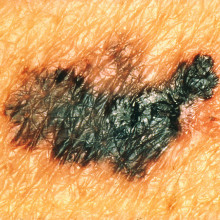
14:50 - Melanoma: how to spot the spots
Melanoma: how to spot the spots
Rhys James
Sarah Ferguson, the Duchess of York, has revealed that she has been diagnosed with malignant melanoma. The 64-year-old author - and former high-profile member of the Royal family - said she was "grateful” for the “love and support" she had received, and urged people to look out for signs of potentially cancerous moles.
Rhys - Malignant melanoma affects more than 300,000 people around the world each year, and its ability to metastasise - or spread - to other parts of the body can make it particularly pernicious. The disease accounts for only 4% of all skin cancers, but is responsible for 75% of deaths caused by these malignancies.
Melanoma UK says your chance of surviving it largely depend on how early it's caught. If it doesn’t spread to your lymph nodes - or another part of your body - then it is highly likely that simply removing it will cure you.
So, what should we know about how it develops in the first place?
Melanoma is caused by ultraviolet light - and in particular UV-B rays - from the sun and also sun tanning beds. The light damages the DNA in melanin-producing cells in the deepest layers of our skin. This stops the cells repairing their DNA from further damage, and locks them into an uncontrolled growth cycle.
Although melanoma cases have roughly doubled since the 1990s, some of us are at greater risk than others. People with fair skin, fair hair and freckles are particularly susceptible, as are those with a history of the disease in their immediate family. Intense and intermittent sun exposure - including frequent sunburn - is associated with the greatest risk. The average age for diagnosis is 66 - but it is not uncommon for people in their 30s to develop it.
Thankfully, greater awareness has led to a reduction in the number of children dying from melanoma in recent years. This has been in no small part due to successful health campaigns run around the world, including in Australia and New Zealand, which have the highest global rates of melanoma. The famous “Slip! Slop! Slap!” campaign in the 1980s - which featured Sid the seagull encouraging people to slip on a shirt, slop on the sunscreen and slap on a hat - remains great advice to reduce and avoid sun exposure.
So, what should we be looking out for if we think something isn’t quite right?
Sarah Ferguson said her melanoma was discovered following the removal of what turned out to be a cancerous mole during treatment for breast cancer. The NHS advice here in the UK says that, in order to catch the disease as early as possible, we should all be looking out for “new” moles, a change in an existing mole, large moles, and even moles that are either an uneven shape or a mixture of colours, and especially those that are particularly dark, itchy or tend to bleed.
If melanoma is caught early, it’s likely that it will not cause further problems. The first step in treatment is usually surgery to remove the affected area and check that it's been completely excised. This is curative in the majority of cases. But some people will present with disease that has already spread from the primary site, or return with a relapse later, in which case patients are treated with chemo- or immunotherapy.
Professor Sarah Allinson has written a great piece in The Conversation about the huge improvements in treatment over the past decade, including the development of drugs, such as dabrafenib and trametinib. These new agents prevent cancerous cells from growing and also allow the immune system to recognise them as hostile and destroy them. Some patients have now been "cured" with these therapies, despite presenting with extensive disease, proving that they can work in some cases. Now the race is on to work out how to make the process as effective for everyone.
Nevertheless, when it comes to cancer, prevention is, of course, always better than cure. So, be sure to remember the advice of Sid the seagull and slip on a shirt, slop on the sunscreen and slap on a hat. And if you notice that you have new moles, a change in an existing mole, or large moles then speak to your doctor and get yourself checked out as soon as possible.
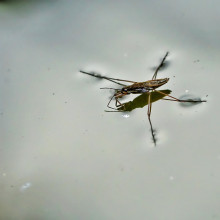
18:58 - How pond skaters dodge raindrop drownings
How pond skaters dodge raindrop drownings
Daren Watson, Florida Polytechnic University
Researchers in the United States have made a big splash in the science field this week by using ultrafast photography to watch what happens when pond skaters - also called water striders in America - are hit by falling raindrops, which massively outweigh the tiny insects. For them, it’s like one of us standing under Niagara Falls, says the study’s author at Florida Polytechnic University, Daren Watson…
Daren - We did this by first capturing the insects from our local ponds and we had to create a rainfall simulator. So we had a reservoir of water that we pumped through a nozzle that mimicked raindrops. Those raindrops struck the insect, and we observed the interaction using our high speed video cameras in the lab.
Chris - So you gave them a shower basically? <laugh>. How fast is fast? When you say high speed imaging, how many pictures a second are you taking of this?
Daren - We can capture up to 4,000 frames per second, so it's very fast. We see the droplets move in on the order of milliseconds.
Chris - Talk us through then, when you look at this footage, what does it show?
Daren - Before we talk about what occurs with the insects, when a raindrop hits a pool of water, what you're going to get is a splash. And we are all familiar with splash. We see this during rainfall, but that splash constitutes a couple different phases. So we see an underwater crater, we see a jet that goes back up above the water surface. And it was important for us to look at how the insect interacts with these different components of the splash. So when the insect is struck by a raindrop, we see that the raindrop pushes the insect into the water body and the insect. You'll find that along the inner surface of that particular raindrop as it creates a crater inside the body of the water. So we find that the insect is, you can say, attached to the water at that point in time. So then when the jet is formed, it is transported out of the water with the jet.
Chris - So the water gets pushed downwards and outwards and compressed by the incoming droplets. And what is a rebound of the water coming back underneath the insect that creates almost like a geyser underneath it that pushes it up in the air?
Daren - Yes. The rebound occurs as the dented surface of the water tries to go back to its original state. So raindrop pushes the insect beneath the water, and then there's a rebound and you have the jet coming upwards.
Chris - Does the action stop there or do you then get secondary effects? Because obviously what goes up must come down. If you've made a jet, do you then get secondary rain effectively off the back of having hit the insect the first time?
Daren - Yes. And that is where the danger lies for the insect because that jet then disintegrates to create what you would've termed secondary rain. And it then pushes the insect inside the body of the water again. And we find that the rebound is going to be so precipitous that the insect is going to be left beneath the waterline.
Chris - Does it have to swim up? And then how does it break through, assuming it does, the surface of the water? Because there's surface tension there between the air and the water isn't there. So how does the insect get back through there and end up on the air side rather than on the water side?
Daren - This is rather innate. So the insect, because the insects are generally born beneath the waterline and their youngs, what they do is they swim to the top to where that waterline is and they break the surface to get onto the airside. So the adults are also able to do that. And they do that through a series of what we call power strokes, applied at an acute angle. And that allows the insect to be able to break that waterline to get back onto the air side of things.
Chris - They obviously do it quite well because there's loads of them. And if I look at the pond near where I live, there's many, many to count. So they're obviously pretty good at this, especially with the terrible weather we have. But what are the applications of this? Because it's interesting and fascinating to understand how these insects have evolved to have this behaviour, but understanding this now as you do, can you apply it to any other aspects of what we see in the marine or aquatic realm?
Daren - Yes, we can. Our results here will allow us to better understand the transport of floating particles like microplastics on the Earth's water bodies. Now microplastics are similar in size to water striders or in your case pond skaters. And they would likely share a similar experience during rainfall. As a matter of fact, in some of our experiments, we replaced water striders with floating particles and observed these similar interactions. So that's the main real world application of the study at the moment. And we're going to be seeking to explore transport of microplastics on our world water bodies going forward.
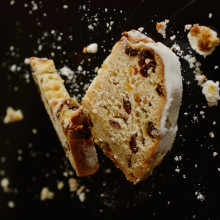
24:42 - Why stollen won't toast
Why stollen won't toast
James Tytko asked baking expert Nicola Lamb to help find the answer. She's the author of 'SIFT: The Elements of Great Baking,' coming out this May...
Celia - Why does stollen go floppy in the toaster instead of crispy? We tried to toast our slices of stollen thinking it would be the Christmas equivalent of toasted hot cross buns, but instead of the crispy, toasted texture we were expecting, our slices became floppy and had to be removed from the toaster with tongs.
James - Thank you, Celia. Now for the uninitiated, this delicious German fruit bread contains marzipan and spices and is inextricably linked to the festive period. I asked culinary queen Nicola Lamb to help find out why Celia's leftover Christmas stollen might have gone sloppy in her toaster. She's the author of SIFT - The Elements of Great Baking, which comes out this May.
Nicola - Stollen is an enriched dough with a relatively high amount of mix-ins in the form of dried fruit and marzipan. So there's problem one. There's relatively less bread to toast.
James - When you toast bread, it undergoes the Maillard reaction, which is a chemical reaction between a reducing sugar and a protein present in the bread dough. The result is that lovely browning crisping effect.
Nicola - Stollen has almost doubled the amount of mix-ins to a dough compared to something like a hot cross bun. Some recipes are about 40% fruit in marzipan by weight. The lower proportion of bread combined with the high proportion of fat in the marzipan and butter in the dough itself will mean the stollen could soften rather than crisp up.
James - Another issue is moisture. The Maillard reaction cannot take place in the presence of water.
Nicola - Just think about the colour of boiled food versus roasted food. In the enclosed space of a toaster, the moisture from all those add-ins, think in particular the buttery steamy marzipan, might result in the stollen steaming rather than toasting.
James - There's just nowhere for the moisture to evaporate, further contributing to your soggy stollen.
Nicola - I expect the traditional powdery sugared crust in most stollen recipes could also be playing a role. I feel like everything matters in baking. It probably attracts quite a lot of moisture to the crust. Since sugar is so strongly hygroscopic, meaning it likes to absorb moisture from the air. In general, I think you'd be better off grilling your stollen, flipping it halfway. That way it has space for the moisture to evaporate and to allow the toasting to happen.
James - Many thanks to Nicola Lamb and be sure to look out for SIFT - the elements of great baking.










Comments
Add a comment